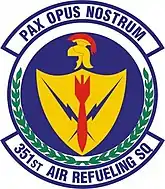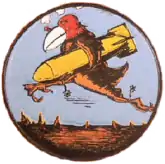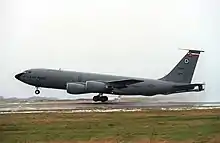351st Air Refueling Squadron
The 351st Air Refueling Squadron (351st ARS) is part of the 100th Air Refueling Wing at RAF Mildenhall, England. Since 1992, it has operated the Boeing KC-135R/T Stratotanker aircraft conducting primarily aerial refueling but also airlift and aeromedical evacuation missions.
351st Air Refueling Squadron
 | |
|---|---|
.jpg.webp) 351st ARS KC-135R Stratotanker 57-1493 at RAF Mildenhall | |
| Active | 1 June 1942 – 15 Dec 1945 17 July 1947 – 27 June 1949 1 Jan 1956 – 25 June 1966 31 Mar 1992 – present |
| Country | |
| Branch | |
| Role | Aerial refueling |
| Part of | United States Air Forces in Europe |
| Garrison/HQ | RAF Mildenhall |
| Motto(s) | Pax Opus Nostrum (Latin for 'Peace is our Profession')[1] |
| Equipment | KC-135R/T Stratotanker |
| Engagements | European Theater of Operations Kosovo War |
| Decorations | Distinguished Unit Citation Air Force Outstanding Unit Award French Croix de Guerre with Palm[1] |
| Insignia | |
| 351st Air Refueling Squadron emblem (approved 16 September 1958)[1] |  |
| Patch with 351st Bombardment Squadron emblem (World War II)[2] |  |
| Squadron code | EP (1942–1945) |
| Tail code | D (1992–present)[3] |
It previously flew the Boeing B-17 Flying Fortress during World War II and the Boeing B-47E Stratojet between 1956 and 1966 as the 351st Bombardment Squadron.
History
World War II

First established as the 351st Bombardment Squadron (Heavy) on 1 June 1942, the squadron flew the Boeing B-17 Flying Fortress from November 1942, initially as part of the Third Air Force in the southeast, before transferring to the Second Air Force in the Pacific Northwest. The 351st BS operated as an Operational Training Unit in the Midwest until being deployed to the European Theater of Operations, being assigned to VIII Bomber Command at RAF Thorpe Abbotts, England, on 9 June 1943.[1]
Engaged in strategic bombardment operations over Occupied Europe and Germany, sustaining very heavy losses of personnel and aircraft while conducting many unescorted missions over enemy territory attacking airfields, industries, naval facilities and transportation hubs. During the summer of 1944, aircrews bombed enemy positions at Saint-Lô, followed by similar campaigns at Brest, France in August and September. In October 1944, the squadron attacked enemy and ground defenses in the allied drive on the Siegfried Line, then bombed marshaling yards, German occupied villages, and communication targets in the Ardennes during the Battle of the Bulge from December 1944 to January 1945. Attacked enemy targets in Germany during the spring of 1945, ending combat operations with the German Capitulation in May 1945.[1]
Remained in Europe as part of the United States Air Forces in Europe occupation forces, dropping food to the people in the west of the Netherlands, and in June transported French Allied former prisoners of war from Austria to France. Demobilizing in England, in December 1945 the squadron inactivated as a paper unit.[1]
Air Force Reserve
Activated in the reserves in 1947 at Miami Army Air Field, Florida. Unclear whether or not the unit was manned or equipped; inactivated in 1949 due to budget restrictions.[1]
Strategic Air Command bombardment operations
The unit was reactivated under Strategic Air Command on 1 January 1956 as the 351st Bombardment Squadron, Medium. Based at Portsmouth Air Force Base (later Pease AFB), New Hampshire, the 351st BS (M) were equipped with 15 new, swept wing Boeing B-47E Stratojets which were designed to carry nuclear weapons and to penetrate Soviet air defenses. The 351st BS (M) deployed to RAF Brize Norton, Oxfordshire, from 29 December 1957 to 1 April 1958.[4]
The squadron flew the B-47 for about a decade when by the mid-1960s it had become obsolete and vulnerable to new Soviet air defenses. The squadron began to send its Stratojets to AMARC at Davis–Monthan AFB, Arizona, for retirement in 1965, and the unit was inactivated on 25 June 1966, one of the last B-47 Squadrons.[1]
Air refueling in Europe

The unit was reactivated at RAF Mildenhall, Suffolk, in the United Kingdom on 31 March 1992 as the 351st Air Refueling Squadron, operating the Boeing KC-135R Stratotanker.[1] The first KC-135R to arrive at Mildenhall for the 351st ARS was 58-0100 on 19 May 1992 from Loring Air Force Base, Maine.[5] Nine KC-135Rs had arrived by September 1992.[6] Following their reactivation, the 351st ARS went on to support Operations Provide Comfort, Restore Hope and Northern Watch.[1]
In April 1996, the 351st ARS contributed to Operation Assured Response, deploying three KC-135s to Dakar-Yoff International Airport, Senegal, to help support the evacuation of U.S. citizens and third country nationals from Liberia after fighting flared up in Monrovia during the First Liberian Civil War.[7][8]
In March 1998, the 351st ARS participated in Exercise Strong Resolve 98 at Sola Air Station, Norway.[9] After the European Tanker Task Force (ETTF) was ended on 28 November 1998, the number of KC-135s assigned to the 351st ARS was increased to 15 tankers.[10] In 1999, the squadron supported Operation Allied Force, NATO intervention during the Kosovo War, as the 351st Expeditionary Air Refueling Squadron (351st EARS).[11]
.jpg.webp)
In October 2001, the 351st EARS deployed 12 tankers: four to Incirlik Air Base, Turkey; another four to Rhein-Main Air Base, Germany; and a final four to Souda Bay, Greece, in support of Operation Enduring Freedom (OEF).[12] On 23 November 2001, KC-135s deployed to Burgas Airport in Bulgaria, from where they conducted OEF missions.[13]
In March 2011, the 351st Air Refueling Squadron deployed a portion of its KC-135 Stratotanker fleet to Istres-Le Tubé Air Base, France, in support of Operation Unified Protector, as the 351st EARS.[14]
Since 2013, the 351st EARS, has regularly deployed to Morón Air Base, Spain in support of Operation Juniper Micron – which aims to assist French operations in Mali.[15][16] The first deployment occurred on 13 January 2013.[17] In June 2013, the 351st ARS refuelled three Luftwaffe McDonnell Douglas F-4F Phantom IIs of JG 71 on their last air-to-air refueling sortie before their retirement on 29 June 2013.[18] In October 2014, the 351st ARS was awarded the 2013 Gen. Carl A. Spaatz Trophy, which is given to the best USAF air refueling squadron, becoming the first unit based outside of the United States to win the award.[19]
On 22 February 2019, KC-135R 57-1493 of the 351st ARS participated in a flypast over Sheffield to mark the 75th anniversary of the crash of B-17G 42-31322 (Mi Amigo), which saw the loss of all ten crew on board.[20] In 2019, to mark the 75th anniversary of Operation Overlord, two KC-135Rs (58-0100 and 62-3551) received special schemes to reflect the squadron's participation in 1944.[21]
Between 29 September and 1 October 2020, the 351st ARS conducted Exercise Wolff Pack, a surge operation to test the 100th ARW's ability to deploy its aircraft to multiple areas across Europe, which included an elephant walk of 12 of the squadron's 15 KC-135s.[22] The 351st ARS participated in the 2020 Nigeria hostage rescue on 31 October, forward deploying six tankers to Morón Air Base from where they provided air refueling support for the operation.[23]
In May 2021, nose art (Skipper III) was unveiled on KC-135R 59-1470 in honour of 100th BG Master Sergeant Dewey Christopher, who maintained B-17s Skipper and Skipper II during World War II.[24] The same month, the 351st ARS were awarded the 2020 Gen. Carl A. Spaatz Trophy, winning it for a second time.[25] The 351st ARS also participated in Exercise Atlantic Trident 2021 during May, operating alongside the French Air and Space Force and USAF F-35A Lightning IIs from the 4th Fighter Squadron.[26][27] Between 18 and 21 May, the 351st ARS hosted the 2021 European Tanker Symposium, which saw a McDonnell Douglas KC-10 Extender and a Royal Air Force Voyager KC3 deploy to Mildenhall.[28]
Another tanker (58-0089) was unveiled the following month in dedication of Lt. Col. Robert "Rosie" Rosenthal, who was assigned to the 100th BG between September 1943 and September 1944.[29]
The 2022 Russian invasion of Ukraine led to an increased number of sorties by the 351st ARS, supporting NATO's Enhanced Air Policing.[30][31]
In October 2023, nose art (Squawkin Hawk) was unveiled on KC-135R 59-1511 to commemorate the 80th anniversary of Black Week, where the Eighth Air Force suffered heavy losses.[32] The original Squawkin Hawk was the first B-17 of the 100th BG to fly 50 combat missions.[33]
Nose art
.jpg.webp)
The 15 based KC-135R/T tankers typically wear nose art to reflect the 100th ARW's history as a Bombardment Group during WWII, since 2023 this has included:[5]
- All American Girl (B-17G 42-37936)[34]
- Big Gas Bird (B-17G 42-30799 of 349th BS)[35]
- Black Jack (B-17G 42-30086)[36]
- Boss Lady (B-17G 42-102611 of 350th BS)[37]
- High Life (B-17F 42-30080)[38]
- Holy Terror (B-17G 42-31062)[39]
- Homesick Angel (not associated)[5]
- Hundred Proof (B-17G 42-98015 of 349th BS)[40]
- Miss Irish (B-17G 42-31968 of 350th BS)[41]
- Our Gal Sal (B-17G 42-31767)[42]
- Skipper III (B-17F 42-3307 & B-17G 42-31708 of 351st BS)[43][44]
- Rosie's Riveters (B-17F 42-30758 & B-17G 42-31504 of 418th BS)[45][46]
- Sly Fox (B-17F 42-30278 of 418th BS)[47]
- Squawkin Hawk (B-17F 42-30088 of 349th BS)[48]
- The Jester (not associated)[5]
- The Reluctant Dragon (B-17G 43-38011 of 349th BS)[49]
- The Savage (B-17G 42-31710 of 349th BS)[50]
- Wolff Pack (B-17F 42-30061 of 418th BS)[51]
Lineage
- Constituted as the 351st Bombardment Squadron (Heavy) on 28 January 1942
- Activated on 1 June 1942
- Redesignated 351st Bombardment Squadron, Heavy on 20 August 1943
- Inactivated on 15 December 1945
- Redesignated 351st Bombardment Squadron, Very Heavy on 3 July 1947
- Activated in the reserve on 17 July 1947
- Inactivated on 27 June 1949
- Redesignated 351st Bombardment Squadron, Medium on 1 August 1955
- Activated on 1 January 1956
- Discontinued and inactivated on 25 June 1966
- Redesignated 351st Air Refueling Squadron on 26 March 1992
- Activated on 31 March 1992[1]
Assignments
- 100th Bombardment Group, 1 June 1942 – 15 December 1945
- 100th Bombardment Group, 17 July 1947 – 27 June 1949
- 100th Bombardment Wing, 1 January 1956 – 25 June 1966
- 100th Operations Group, 31 March 1992 – present[1]
Stations
- Orlando Army Air Base, Florida 1 June 1942
- Barksdale Field, Louisiana, c. 18 June 1942
- Pendleton Field, Oregon c. 26 June 1942
- Gowen Field, Idaho, 28 August 1942
- Walla Walla Army Air Field, Washington, c. 1 November 1942
- Wendover Field, Utah, c. 30 November 1942
- Sioux City Army Air Base, Iowa, c. 28 December 1942
- Kearney Army Air Field, Nebraska, c. 30 January – May 1943
- RAF Thorpe Abbotts (Station 139),[52] England, 9 June 1943 – December 1945
- Camp Kilmer, New Jersey, c. 20–21 December 1945
- Miami Army Air Field, Florida, 29 May 1947 – 27 June 1949
- Portsmouth Air Force Base (later Pease Air Force Base), New Hampshire, 1 January 1956 – 30 April 1966
- RAF Mildenhall, England, 31 March 1992 – present[1]
Aircraft operated
- Boeing B-17 Flying Fortress (1942–1945)
- Boeing B-47E Stratojet (1956–1966)
- Boeing KC-135R/T Stratotanker (1992–present)[1]
References
- Kane, Robert B. (19 July 2010). "Factsheet 351 Air Refueling Squadron (USAFE)". Air Force Historical Research Agency. Retrieved 24 July 2017.
- Watkins, pp. 48–49
- Duffield, Adam (23 May 2014). "100th ARW in Action". Aero Resource. Retrieved 9 January 2021.
- "100th Air Refueling Wing History". Royal Air Force Mildenhall. 23 July 2019. Retrieved 10 January 2021.
- "Planes, Names and Noses: KC-135s of the 100th ARW". key.aero. 15 August 2019. Retrieved 8 January 2021.
- Abeyasekere, Karen (1 February 2017). "100th Air Refueling Wing celebrates a historic 25 years". Royal Air Force Mildenhall. Retrieved 10 January 2021.
- Haulman, Daniel L. (November 2006). "HUMANITARIAN AIRLIFT OPERATIONS IN WHICH USAF PARTICIPATED SINCE 1994" (PDF). Air Force Historical Research Agency. Retrieved 10 January 2021.
- "Operation Assured Response". GlobalSecurity.org. Retrieved 10 January 2021.
- "Exercise Strong Resolve 1998" (PDF). North Atlantic Treaty Organization. Retrieved 16 May 2021.
- "Visiting Forces in the UK: 1942–2011" (PDF). Royal Air Force Mildenhall. Retrieved 10 January 2021.
- "Operation Allied Force - Order of Battle - June 1999". GlobalSecurity.org. Retrieved 10 January 2021.
- Wallace, Kevin (2 September 2011). "9/11's affect on 100th ARW mission". Royal Air Force Mildenhall. Retrieved 14 January 2021.
- "351st Air Refueling Squadron [351st ARS]". GlobalSecurity.org. Retrieved 14 January 2021.
- Senior Airman Rachel Waller. "RAF Mildenhall continues support for NATO Libyan operations". mildenhall.af.mil. Archived from the original on 17 March 2013. Retrieved 6 November 2012.
- Smith, Jason (1 February 2013). "KC-135s support French mission in Mali". U.S. Air Forces in Europe & Air Forces Africa. Retrieved 14 January 2021.
- "RAF Mildenhall KC-135 aircraft supports Operation Juniper Micron". U.S. Air Forces in Europe & Air Forces Africa. 26 February 2020. Retrieved 14 January 2021.
- Mesnard, Christopher (1 February 2013). ""Bloody Hundredth" flies back into action". United States Africa Command. Retrieved 14 January 2021.
- Wills, Kevin (25 June 2013). "Aviation Feature – The Phinal Contacts: F-4F Phantom refuelling – from tanker & receiver". Global Aviation Resource. Retrieved 14 January 2021.
- Maurer, Kate (18 November 2014). "351st ARS makes history by winning Spaatz Trophy, a first for units abroad". Royal Air Force Mildenhall. Retrieved 16 May 2021.
- "Sheffield bomber crash: Flypast on 75th anniversary". BBC News. 22 February 2019. Retrieved 17 February 2021.
- "Legacy Ladies - Nose Arts of the 100th Air Refuelling Wing". Square Aviation. 6 June 2019. Retrieved 9 January 2021.
- Oprihory, Jennifer-Leigh (1 October 2020). "Tankers Practice Speedy Deployment in European Refueling Exercise". Air Force Magazine. Retrieved 14 January 2021.
- Cenciotti, David (9 November 2020). "Dissecting The U.S. Hostage Rescue Operation In Nigeria: Here Are All The Assets That Took Part In The Raid". The Aviationist. Retrieved 8 January 2021.
- Abeyasekere, Karen (11 May 2021). "'Skipper III' nose art dedication recognizes special bond, legacy of 100th Bomb Group". Royal Air Force Mildenhall. Retrieved 16 May 2021.
- Mendez, Mackenzie (14 May 2021). "351st named best ARS in Air Force". Royal Air Force Mildenhall. Retrieved 16 May 2021.
- "Exercise Atlantic Trident 2021". U.S. Air Forces in Europe & Air Forces Africa. 16 April 2021. Retrieved 21 June 2021.
- Barron, Joseph (18 June 2021). "100th Air Refueling Wing fuels F-35s during exercise Atlantic Trident". Royal Air Force Mildenhall. Retrieved 21 June 2021.
- Abeyasekere, Karen (24 May 2021). "RAF Mildenhall hosts European Tanker Symposium". Royal Air Force Mildenhall. Retrieved 21 June 2021.
- Abeyasekere, Karen (11 June 2021). "'Rosie's Riveters' nose art dedication immortalizes legacy of 100th BG pilot with 100th ARW". Royal Air Force Mildenhall. Retrieved 21 June 2021.
- "100th ARW provides refueling support to aerial assets in support of contingency and routine operations". Royal Air Force Mildenhall. 2 March 2022. Retrieved 5 August 2022.
- Hadley, Grey (3 August 2022). "USAFE's Only Tanker Wing: Increased Work, But 'Increased Reward, Too'". Air Force Magazine. Retrieved 5 August 2022.
- Villagomez, Alvaro (10 October 2023). "RAFM honors Black Week: KC-135 "Squawkin' Hawk" nose art". Royal Air Force Mildenhall. Retrieved 14 October 2023.
- "Aircraft: 230088". 100th Bomb Group Foundation. Retrieved 14 October 2023.
- "42-37936". American Air Museum in Britain. Retrieved 8 January 2021.
- "42-30799". American Air Museum in Britain. Retrieved 8 January 2021.
- "Aircraft: 230086". 100th Bomb Group Foundation. Retrieved 8 January 2021.
- "42-102611". American Air Museum in Britain. Retrieved 8 January 2021.
- "42-30080". American Air Museum in Britain. Retrieved 8 January 2021.
- "42-31062". American Air Museum in Britain. Retrieved 8 January 2021.
- "Aircraft: 298015". 100th Bomb Group Foundation. Retrieved 8 January 2021.
- "42-31968". American Air Museum in Britain. Retrieved 8 January 2021.
- "42-31767". American Air Museum in Britain. Retrieved 8 January 2021.
- "Aircraft: 23307". 100th Bomb Group Foundation. Retrieved 16 May 2021.
- "Aircraft: 231708". 100th Bomb Group Foundation. Retrieved 16 May 2021.
- "Aircraft: 230758". 100th Bomb Group Foundation. Retrieved 11 June 2021.
- "Aircraft: 231504". 100th Bomb Group Foundation. Retrieved 11 June 2021.
- "42-30278". American Air Museum in Britain. Retrieved 8 January 2021.
- "42-30088 Squawkin Hawk II". American Air Museum in Britain. Retrieved 14 October 2023.
- "43-38011". American Air Museum in Britain. Retrieved 8 January 2021.
- "42-31710". American Air Museum in Britain. Retrieved 8 January 2021.
- "42-30061". American Air Museum in Britain. Retrieved 8 January 2021.
- Station number in Anderson.
Bibliography
![]() This article incorporates public domain material from the Air Force Historical Research Agency.
This article incorporates public domain material from the Air Force Historical Research Agency.
- Anderson, Capt. Barry (1985). Army Air Forces Stations: A Guide to the Stations Where U.S. Army Air Forces Personnel Served in the United Kingdom During World War II (PDF). Maxwell AFB, AL yes: Research Division, USAF Historical Research Center. Archived from the original (PDF) on 23 January 2016. Retrieved 28 June 2017.
- Maurer, Maurer, ed. (1983) [1961]. Air Force Combat Units of World War II (PDF) (reprint ed.). Washington, DC: Office of Air Force History. ISBN 0-912799-02-1. LCCN 61060979.
- Maurer, Maurer, ed. (1982) [1969]. Combat Squadrons of the Air Force, World War II (PDF) (reprint ed.). Washington, DC: Office of Air Force History. ISBN 0-405-12194-6. LCCN 70605402. OCLC 72556.
- Ravenstein, Charles A. (1984). Air Force Combat Wings, Lineage & Honors Histories 1947–1977. Washington, DC: Office of Air Force History. ISBN 0-912799-12-9. Retrieved 17 December 2016.
- Watkins, Robert (2008). Battle Colors: Insignia and Markings of the Eighth Air Force in World War II. Vol. I (VIII) Bomber Command. Atglen, PA: Shiffer Publishing Ltd. ISBN 978-0-7643-1987-7.
